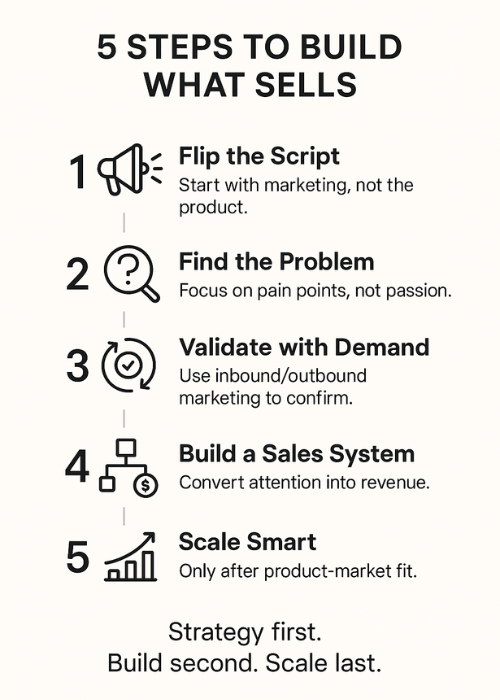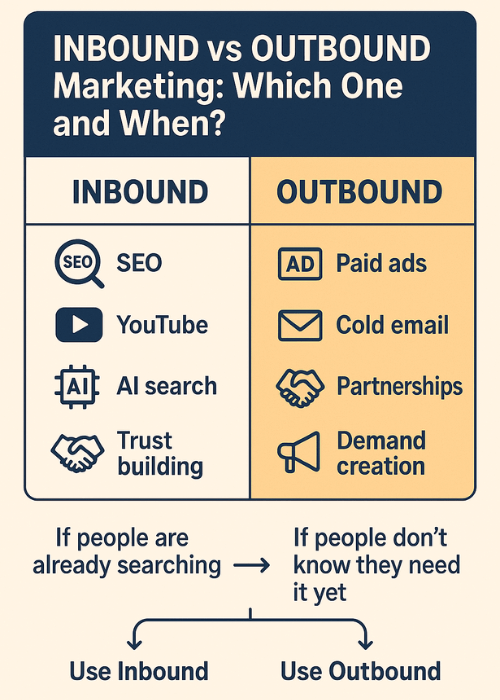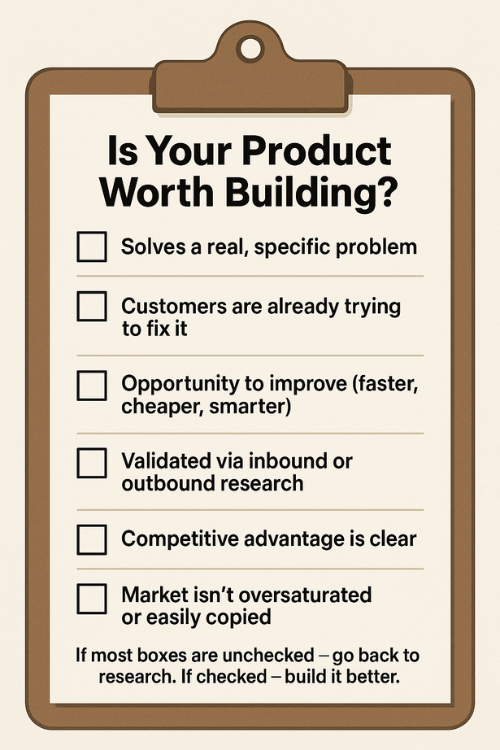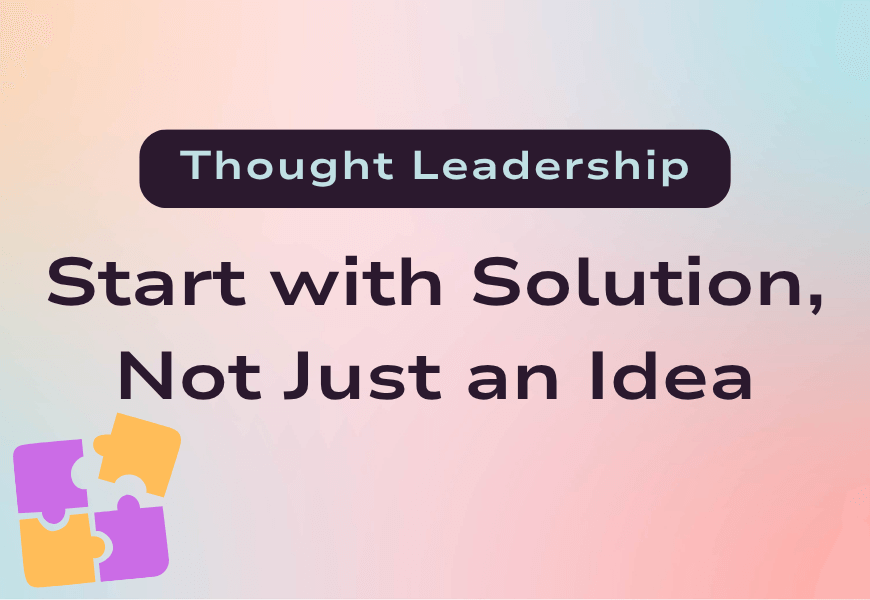Build What Sells: Start with a Solution, Not Just an Idea
If you’re thinking about starting a product- or service-based business in 2025, there’s a lot more to success than just having a great idea. With the AI boom reshaping industries and competition intensifying, strategy matters more than ever.
You need to choose the right product, validate the demand, master discovery, and align marketing and sales before you even think about scaling. In this guide, I’ll walk through a proven, practical approach to launching a new business the right way.

Step 1: Understand Marketing Before You Build Anything
In most businesses, production comes first. You build something, then figure out how to sell it. But that approach is backward.
Marketing should come first.
Why? Because marketing helps you validate whether your idea is even worth building. And more importantly, it tells you how to position it from day one.
Let’s start by breaking down the two core types of marketing:
Inbound vs. Outbound Marketing
What Is Inbound Marketing?
Inbound marketing is when your ideal customers come to you. They already know they have a problem, and they’re actively looking for a solution.
That means:
- The market already exists.
- People are searching.
- There’s opportunity, but also saturation.
So your job is to stand out, not start from scratch.
How to Win in a Crowded Market
You don’t have to reinvent the wheel—you just have to offer a better version of it.
Ask yourself:
- Can you add unique or smarter features?
- Can you offer a better price?
- Can you deliver faster or more reliable results?
- Can AI or automation make it more efficient?
Even a 10–20% improvement can be enough to get traction, especially if you’re easy to discover.
Discovery Optimization: The Heart of Inbound Strategy
Once you’ve built something better, your next job is to be found. This is what discovery optimization is all about.
Your customers are already looking for solutions. So make sure they find yours when they search:
- On Google and AI-enhanced search engines (SGE, Perplexity)
- On social media (TikTok, Instagram, Pinterest, LinkedIn)
- On AI tools (ChatGPT, Gemini, Claude)
Organic visibility = organic growth. And that’s the power of inbound done right.
What Is Outbound Marketing?
Outbound is the opposite; it’s when you go to your audience.
Use this when:
- You’ve built something brand-new or innovative
- You’ve improved tech in a way the market hasn’t seen
- Your target users don’t know they need your solution yet
In these situations, people aren’t actively searching for what you’re offering, which means you have to create the demand.
Creating Demand with Outbound Marketing
Outbound marketing pushes your product in front of the right people before they go looking for it. Some proven tactics:
- Paid ads (Google, YouTube, Instagram, LinkedIn)
- Cold outreach via email or LinkedIn
- Partnerships (influencers, affiliates)
- Product demos, storytelling, and educational content
When outbound is done well, especially with a real, unsolved problem, it sparks curiosity, interest, and conversions.

Why Marketing Must Come Before Production
Marketing is more than promotion. It’s how you identify the right opportunity.
Inbound helps you tap into existing demand.
Outbound helps you generate new demand.
Both help you validate what’s worth building before you build it.
When your product aligns with how the market behaves, growth feels natural. When it doesn’t, every step is harder than it needs to be.
Step 2: Choose the Right Product or Service
With your marketing foundation laid, it’s time to talk about product strategy.
This step is where most entrepreneurs mess up.
Don’t Start with Passion or Skills Alone
You might love a niche. You might be highly skilled. But if your offer doesn’t solve a real problem for someone else, it’s just a hobby not a business.
Passion gives you stamina. Skills help with execution. But only demand creates income.
Start with Problems, Not Ideas
Flip your thinking.
Start with observation:
- What do people complain about?
- What solutions do they already use?
- What frustrates them?
- What feels outdated, clunky, expensive, or inefficient?
Then ask: Can I build something simpler, smarter, faster, or cheaper?
That’s where opportunity lives in solving pain, not in pursuing your preferences.
Your Product = A Solution, Nothing More
Your product or service is a fix to someone’s problem. That’s it.
If it doesn’t fix something, it won’t sell.
That’s why early research matters. Find real-world struggles. Craft something useful. Then build a story around that solution.
Think Strategically: Saturation, Differentiation & Survival
Once you have an idea, pressure-test it:
- Is the market already crowded?
- What are the top competitors doing?
- Where are they falling short?
- How can you stand apart?
Also think long-term:
- What happens when someone copies you?
- What can you build that’s hard to replicate?
Use Porter’s Five Forces to Stress-Test Your Idea
- Competitive Rivalry: Who else is solving this problem?
- Threat of New Entrants: Can someone else do this easily?
- Threat of Substitutes: Are there workarounds or alternatives?
- Buyer Power: Do customers control pricing, or have many options?
- Supplier Power: Are you reliant on third-party providers?
This lens helps you build not just for launch but for staying power.
Branding Is Your Moat
In a crowded market, branding is how you survive. Not logos or colors but positioning.
Your brand should be the default thought when someone experiences the problem you solve. That’s what separates you from everyone else.
And it starts with a strong, real solution.

Step 3: Connect Product, Marketing, and Sales to Drive Revenue
Let’s bring it all together.
You’ve chosen the right solution. You’ve validated the demand. Now it’s time to bring in attention and turn that into revenue.
Choose the Right Marketing Channels (Inbound vs. Outbound)
Inbound Marketing Tactics:
- SEO for Google and SGE-style search
- AI Search Optimization for ChatGPT, Perplexity, Claude, etc.
- Content Marketing: YouTube videos, blog posts, reels, guides, LinkedIn posts
Inbound builds trust and organic traffic. It takes time, but it compounds.
How to Win:
- Hire SEO/content creators who understand your market
- Publish consistently
- Create value-first content
- Optimize for discovery but stay human
Outbound Marketing Tactics:
- PPC Ads (Google, Meta, YouTube, LinkedIn)
- Cold Email Campaigns
- Influencer & Affiliate Programs
- Demos & Outreach
Outbound gives faster results and works best when paired with a well-built funnel.
How to Win:
- Build high-converting landing pages
- Target precisely, segment messaging
- Retarget and optimize continuously
- Leverage credibility from partners
Step 4: Build a Sales System That Converts
Marketing brings attention. Sales turn that into money.
Your sales strategy should:
- Recover abandoned carts (via emails or retargeting)
- Send newsletters with offers, updates, and urgency
- Upsell or cross-sell to increase revenue per customer
- Reduce churn with smart retention offers
- Build loyalty through value and personalization
- Use feedback to keep improving
A good sales system boosts revenue and long-term satisfaction.
Step 5: Scale Smart, Not Fast
Once you’ve proven product-market fit and you’re consistently closing sales, then and only then should you think about scaling.
Focus on:
- Strengthening your business model
- Automating operations
- Protecting your brand
- Differentiating defensibly
Scaling before validation leads to burnout and budget waste. Scale after foundation = sustainability.
Final Thoughts
If you want to launch a successful business in 2025, don’t start with your passion; start with the market’s pain.
Solve a real problem.
Validate that demand with marketing before you build anything.
Craft a solution that’s better than what exists.
Then connect smart marketing with a sales system that converts.
Do this right, and you’ll build something with momentum where each part reinforces the other, and growth starts to feel like a flywheel instead of a fight.
Frequently Asked Questions (FAQs)
How do I know if my product solves a real problem?
Look where people vent, such as Reddit, forums, and reviews. If they’re frustrated, using clunky tools, or hacking workarounds, you’ve got a signal.
Can I use both inbound and outbound marketing?
Definitely. Inbound builds trust and visibility over time. Outbound gets immediate reach. Together, they form a full-spectrum strategy.
How do I decide which channel to use first?
If people are already searching, start inbound. If they’re unaware of the need, go outbound. Test, measure, then adjust.
When should I scale?
After product-market fit, repeatable customer acquisition, and clear profitability. Don’t scale chaos.
Do I need a sales team for digital products?
Not always. For low-ticket products, automation is enough. For high-ticket B2B or complex solutions, a skilled sales team is crucial.

